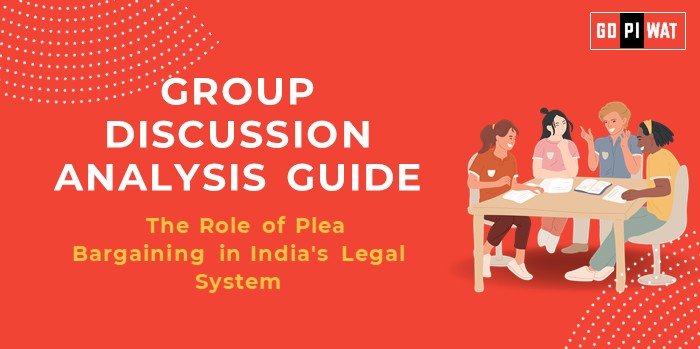📋 GD Analysis Guide: The Role of Plea Bargaining in India’s Legal System
🌐 Introduction to the Role of Plea Bargaining
- ⚖️ Opening Context: “Plea bargaining is a tool to expedite justice delivery, balancing legal efficiency and individual rights. Introduced in India in 2005, its relevance has grown with the increasing backlog of court cases.”
- 📜 Topic Background: Originally a concept from Anglo-American law, plea bargaining was incorporated in India under Chapter XXIA of the Criminal Procedure Code, 1973. It aims to alleviate the judicial system’s burden and provide quick resolutions for certain types of cases.
📊 Quick Facts and Key Statistics
- 📉 Case Backlog: 4.5 crore pending cases in Indian courts (2023) – Plea bargaining can help mitigate delays.
- 🏢 Prison Overcrowding: 77% of Indian prison inmates are undertrials – Plea bargaining offers a resolution mechanism.
- 📜 Legislative Coverage: Applicable for offenses with imprisonment up to seven years, excluding social or economic offenses.
- 🌍 Global Context: In the US, 90% of criminal convictions result from plea bargains, demonstrating its efficiency.
👥 Stakeholders and Their Roles
- ⚖️ Judiciary: Implements plea bargaining mechanisms.
- 👤 Accused Individuals: Seek reduced sentences or penalties.
- 📢 Legal Counsel: Ensure fair representation and informed consent.
- 👨👩👦👦 Victims: Agree to or contest plea bargains as part of the resolution process.
- 🏛️ Legislature: Draft laws governing its scope and application.
🏆 Achievements and Challenges
✨ Achievements:
- 📂 Case Resolution Speed: Faster case disposals reduce pendency.
- 💰 Reduced Trial Costs: Lowers costs for both judiciary and accused.
- 🚪 Prison Decongestion: Benefits undertrial prisoners through quicker decisions.
- 🌍 Global Inspiration: Adopted best practices from developed countries.
⚠️ Challenges:
- ⚖️ Justice Compromise: Risk of coercion or inequality in bargaining power.
- 📜 Limited Scope: Excludes major and socio-economic offenses.
- 📉 Awareness Gap: Limited understanding among eligible beneficiaries.
🌏 Global Comparisons
- 🇺🇸 US: High reliance on plea bargaining with strict regulatory oversight.
- 🇩🇪 Germany: Employs judicial discretion to safeguard justice in plea bargains.
📖 Case Studies:
- 📂 India: NALSA has documented success stories of undertrial release via plea bargaining.
- 🏛️ Kerala: Effective pilot projects for low-stakes cases.
🗣️ Structured Arguments for Discussion
- ✅ Supporting Stance: “Plea bargaining expedites justice for minor offenses, reducing systemic delays.”
- ❌ Opposing Stance: “Plea bargaining risks compromising the integrity of justice by prioritizing efficiency over fairness.”
- ⚖️ Balanced Perspective: “While plea bargaining accelerates case resolutions, it requires safeguards against coercion and inequality.”
💡 Effective Discussion Approaches
✨ Opening Approaches:
- 📜 “India’s 4.5 crore pending cases highlight the critical need for innovative solutions like plea bargaining.”
- 🚪 “The plea bargaining system offers a beacon of hope for India’s overcrowded prisons.”
- ⚖️ “Justice delayed is justice denied—plea bargaining could help India address this reality.”
🔄 Counter-Argument Handling:
- 📢 Emphasize the need for legal counsel to prevent exploitation.
- 📚 Suggest increased awareness campaigns and legal reforms.
⚡ Strategic Analysis of Strengths and Weaknesses
- 💪 Strengths: Reduces delays, decongests prisons, cuts trial costs.
- 🚫 Weaknesses: Limited coverage, potential misuse, lack of awareness.
- 🚀 Opportunities: Expand scope with better safeguards, train stakeholders.
- ⚠️ Threats: Risk of miscarriage of justice if unregulated.
📚 Connecting with B-School Applications
- 🏢 Real-World Applications: Discussion on legal efficiency and policy design.
- 🤔 Sample Interview Questions:
- 📜 “How can plea bargaining ensure fairness while accelerating case resolutions?”
- 📉 “Evaluate plea bargaining’s role in reducing India’s undertrial population.”
- 💡 Insights for Students: Opportunities in judicial policy research and public administration projects.


